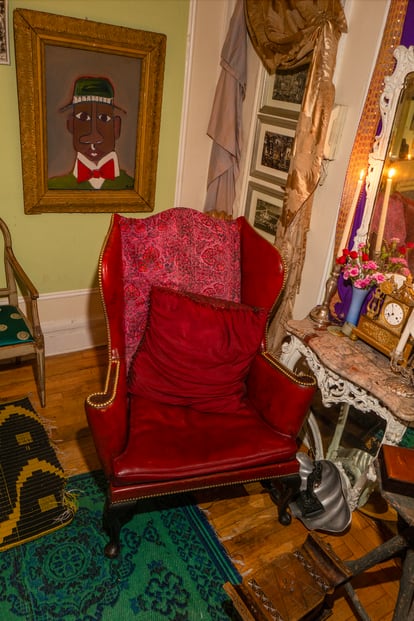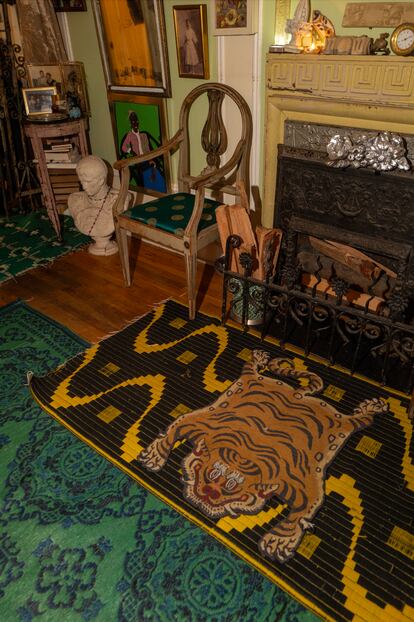When I was a child, Michael Henry Adams watched movies like gone With the Wind (1939) and The exotic (1945) and was attracted to the sumptuous mansions of the southern United States. But as an African-American child, he was also aware that his race made it difficult for him to be a landlord in that context. “I then thought about transferring my taste to the houses built at the end of the 19th century in Newport, Rhode Island, which were also fantastic, but it didn't take me long to realize that it had also been the second most important port of entry for slaves in the country. “If I looked at England, I was fascinated by the houses of the Harewood dynasty, but it turned out that their fortunes came from the plantations in Jamaica,” he says. In other words, it seemed difficult for him to be a lover of interior design without betraying his own people. His father had already warned him when he told her that he wanted to be an artist at the age of 14: that was only for whites. His mother, a little more in favor of him pursuing his passions, told him that everyone who was dedicated to decorating was “a little strange.”
He was born in Ohio, Akron, in 1956, but when he left “as soon as possible” for New York in the eighties, he saw that in Harlem there was an aesthetic splendor that did not stain his hands with blood. They were the echoes of the call Renaissance of the neighborhood, the golden age of African American culture that lasted from 1910 to the mid-1930s. The era of the Cotton Club, of the poet Claude McKay, of the intellectual leadership of WEB Du Bois. Sumptuous halls, terracotta facades, chiseled cornices. A legacy that was threatened with the entry of Reagan's neoliberalism and the first steps of gentrification. And that's when Adams found his mission in life: to defend, preserve and write about some of the historic places for his community. Becoming a kind of archaeologist of an architecture that is too recent, too unknown and with economic and institutional intentions of being buried. “Harlem hardly had places protected for their historical interest. Today there are barely 20. The office that is in charge of naming them continues to think about buildings for white elites. And they still treat us like they are doing us a favor every time they add one of ours to their list of protected buildings,” he protests. He was arrested twice for his protests against the demolition of the Renaissance casino (which he could not prevent) and the Audubon dance hall, in one of whose rooms Malcolm X was assassinated. “They only respected the façade and a third of the lobby . At the time I said, and I guess I was wrong, that they could have demolished it for that, that it was a scam. Would they do the same with the theater where Lincoln was assassinated? ”He asks.

Thus, Adams became a beauty activist. She fought on the street and in municipal offices, but she has also been a firm member in the New York Times and in Guardianin addition to having written books like Harlem: Lost and Found (2002) and Style and Grace: African Americans at Home (2003). And in the face of the apathy of the authorities and even his own neighbors, he took pieces of all those buildings to his house, which today is unofficially a peculiar museum of the history of the neighborhood. It has moldings from the old Lafayette Theater, which was located on 135th Street. Duke Ellington debuted there, Orson Welles premiered his Voodoo Macbeth and that was also where Francis Ford Coppola filmed the film Cotton Club, in the absence of the original space. It was demolished in 2013. The aforementioned Audabon has a silver garland in the lobby. And it also preserves fragments of friezes from another lobby, this time that of the former Harlem Chamber of Commerce.

It all sounds very luxurious and encyclopedic, but Adams actually lives in a kind of trompe l'oeil that hides his precariousness. “I was always broke. Maybe because people ha
te that you are confrontational and that you challenge them,” he says, still unbribable. His life story includes scenes with Harry Belafonte and first-hand anecdotes about Sidney Poitier with mice in the walls and leaks in the room. His good taste, there is no doubt, has helped him turn his cloak into a tunic: in a dark room he uses almost only candle lighting, even in his charming chandelier, as if it were a nineteenth-century palace. He has a pair of wall sconces (stolen from the rubble of an old synagogue) that hold electric candles, but he justifies that at Charles and Camilla's reception in Versailles they had also switched to these fake candles. He happens in the best families. And he is, of course, a great host who welcomes us into his house with exquisite breakfast china and a three-tier tray of raspberries and pastries. He pours a glass of coffee from the corner deli into his porcelain mug. He confesses that of the hundreds of pieces that litter his living room, none has cost more than $35 and that some pieces were rescued from the trash. Also on the walls of his house his own story is told, of course: there is a life-sized photograph of his father when he played basketball, a photo of Martin Luther King taken by his grandfather and some drawings made By himself. A home as humble as it is sumptuous that captivates him to the point that his doctor worries because he doesn't leave the house. “He tells me that I have chronic depression, but I don't think it's bad that I don't feel like leaving here.” He resides in one of those buildings that he fought to convert into a protected space without success, at number 41 Convent Street. Its first African-American resident was actor Fredrick O'Neal, founder of the American Negro Theater in 1940, and its peculiar vaulted lobby connects three triplet buildings built almost 100 years ago, in 1926.

But their fight continues. Already in the 21st century, his main enemy has turned out to be the university to which he one day found himself linked: Columbia, which has ended up becoming a kind of real estate steamroller with new glass installations and impersonal buildings to house students who raise the incomes of lifelong citizens. “It is one of the worst things that has happened to the neighborhood. They fill their mouths saying that it has an integrative and knowledge mission, but they do not stop building buildings that look like factories,” criticizes.
He also had his ups and downs with the late Senator Bill Perkins, a Democrat and African-American, serving the state of New York. “We were friends, but he accused me of being bourgeois, and they considered it more important to convert old buildings into housing blocks with rent-controlled apartments for low-income people,” explains Adams, “but if our neighborhood is a unique and authentic place, which one “Is the point of turning it into a place that could be any place in the world?” On occasions, he even defended the white people who “exquisitely” restored some of the houses in the neighborhood, although he later expressed his surprise when he saw that they were sold after a short time. “It seems like the real estate agent had told them that in a few years the blacks would be gone, but that didn't happen.”

#Michael #Henry #Adams #man #preserves #Harlem #speculators #believed #blacks #leave